As I’ve already said in the previous sequel of the story, perhaps the most interesting part of the Nunnery Quadrangle in Uxmal is the palace on the west side of this complex structure. On the one hand, it has the best lighting in the morning, on the other, it has been brilliantly restored, and on the third one it has the most opulent stone decoration.
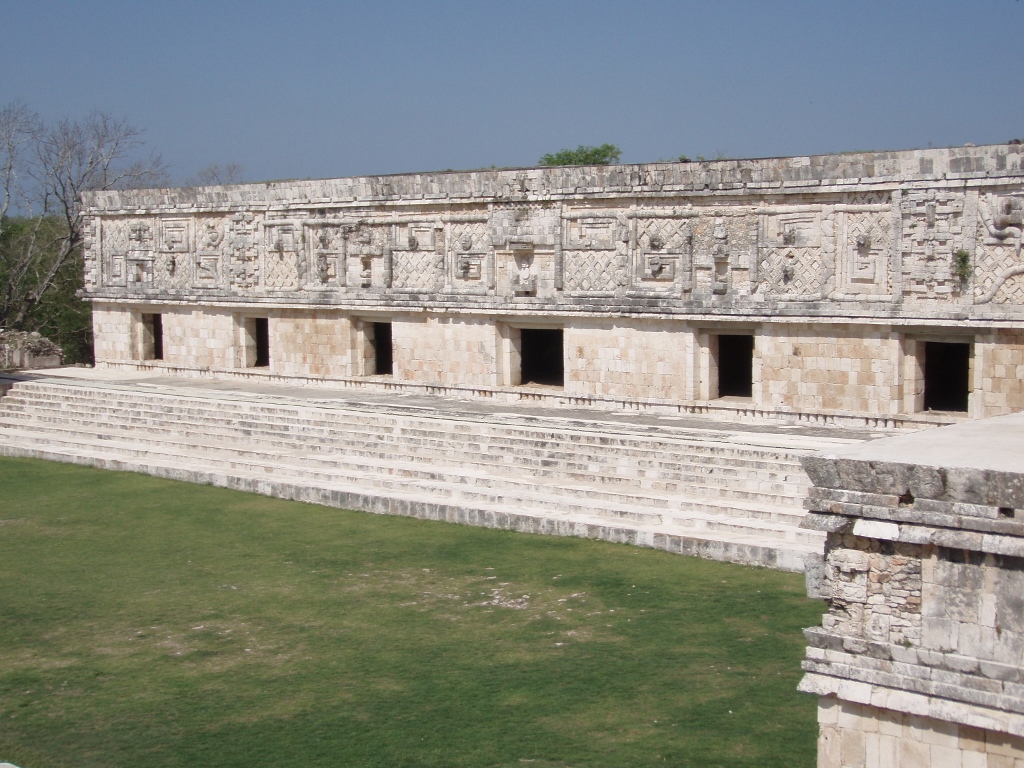 Nunnery Quadrangle – the west palace
Nunnery Quadrangle – the west palace
A prominent place within this stone decoration that perfectly reflects the Puuc artistic and architectural style is certainly taken by the numerous depictions of Chaac – the god of rain and thunder.
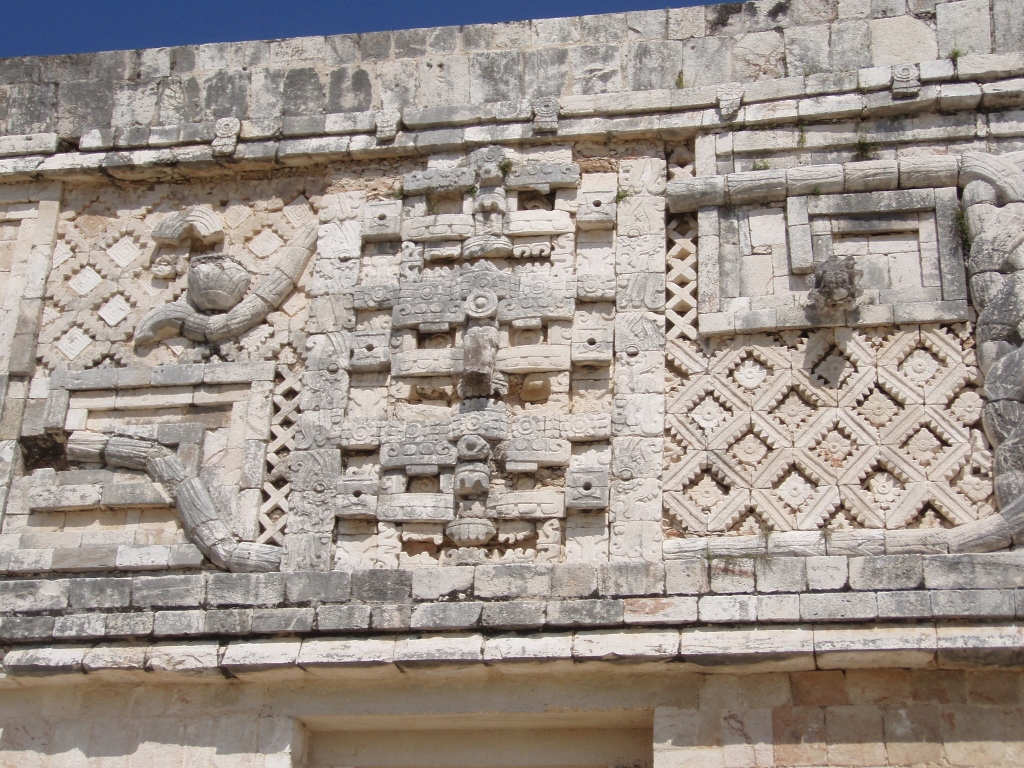 Three depictions of god Chaac placed one on top of the other
Three depictions of god Chaac placed one on top of the other
But, there is also a myriad of other symbols which I must say I don’t have a clue as to what they represent and, no matter how much I enjoyed my own experience, in this place I could not help but wonder how much more this would be enjoyed by some serious historians of art who deal with the study of the ancient Maya civilisation.
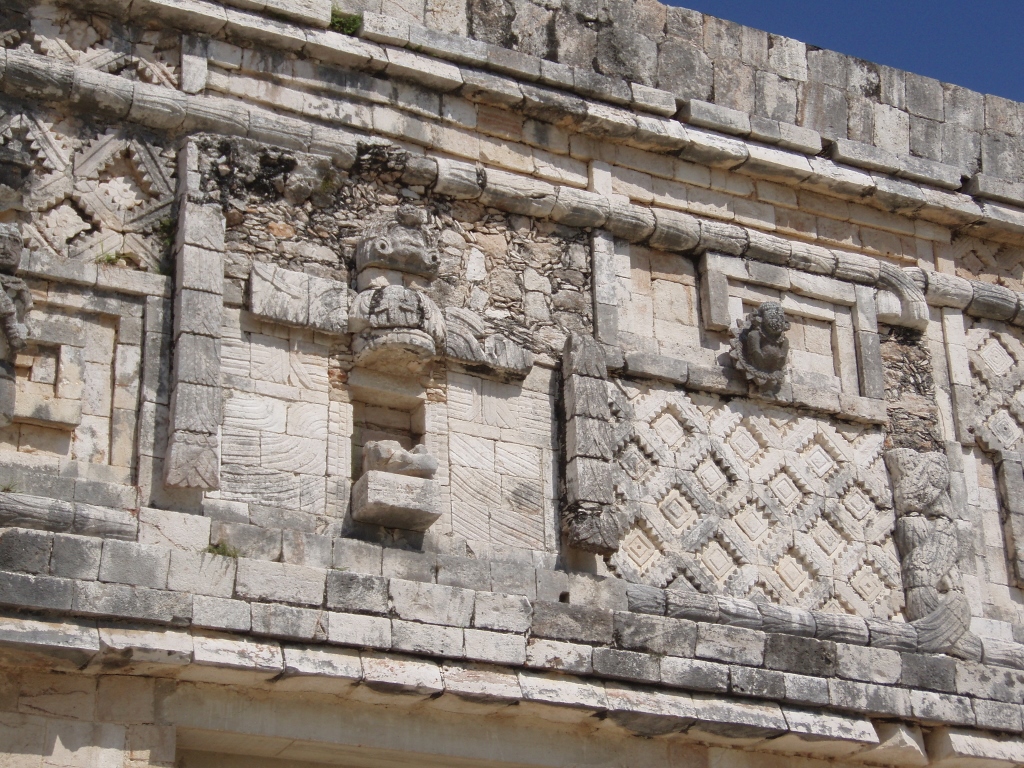 Opulent stone decoration on the facade of the west palace within the Nunnery Quadrangle
Opulent stone decoration on the facade of the west palace within the Nunnery Quadrangle
I have already said before that one of the characteristics of the Puuc architectural and artistic style is that complex and very rich depictions are created in the upper section of the facade with exceptionally skilful fitting of the dressed stones, which in the end creates a large mosaic. In addition to the abstract ornamental sections and god Chaac, there are also human figures, owls, jars, turtles and it is said that there are also depiction of planet Venus, as well as of Tlaloc, the version of Chaac from the present-day central Mexico, i.e., the god of rain and thunder from the Aztec pantheon. As far as this “exchange” of deities is concerned, to the present times it remains an open question among researchers whether the Aztec took over this symbolism from the Maya or if it was vice versa.
The same thing exists in the case of deity Kukulkan called Quetzalcoatl among the Aztecs, while the symbolism and meaning are the same – it’s the feathered serpent. I think that it was precisely here during the sightseeing that I came across information that Kukulkan is a combination of a bird and a rattlesnake, hence the feathered serpent. The fact that this is a rattlesnake may be seen nicely precisely on the front facade of the west palace in Uxmal. In one section of this richly decorated facade it is possible to see Kukulkan that slithers, as well as its end – and there is the rattle.
I have also come across information that the Postclassic Mayan depictions of Kukulkan are often done in the shape of a feathered serpent with open mouth from which protrudes the head of a human warrior and that can also be seen in the photo below.
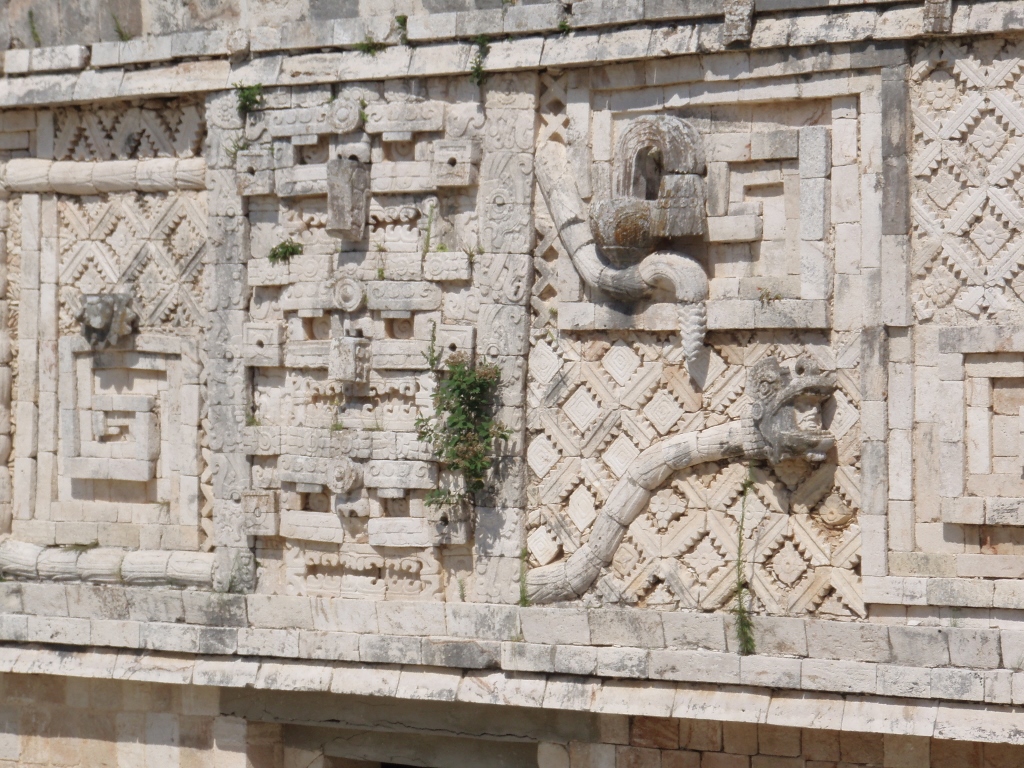 Beginning and the end of Kukulkan as a part of the opulent decoration on the facade of the west palace of the Nunnery Quadrangle; on the left-hand side there is god Chaac again
Beginning and the end of Kukulkan as a part of the opulent decoration on the facade of the west palace of the Nunnery Quadrangle; on the left-hand side there is god Chaac again
As I left the Nunnery Quadrangle through a passage in the south palace that is situated on a mild elevation, I could see a ballcourt down a wide path for visitors. Of course, it is significantly smaller than the one in Chichén Itzá.
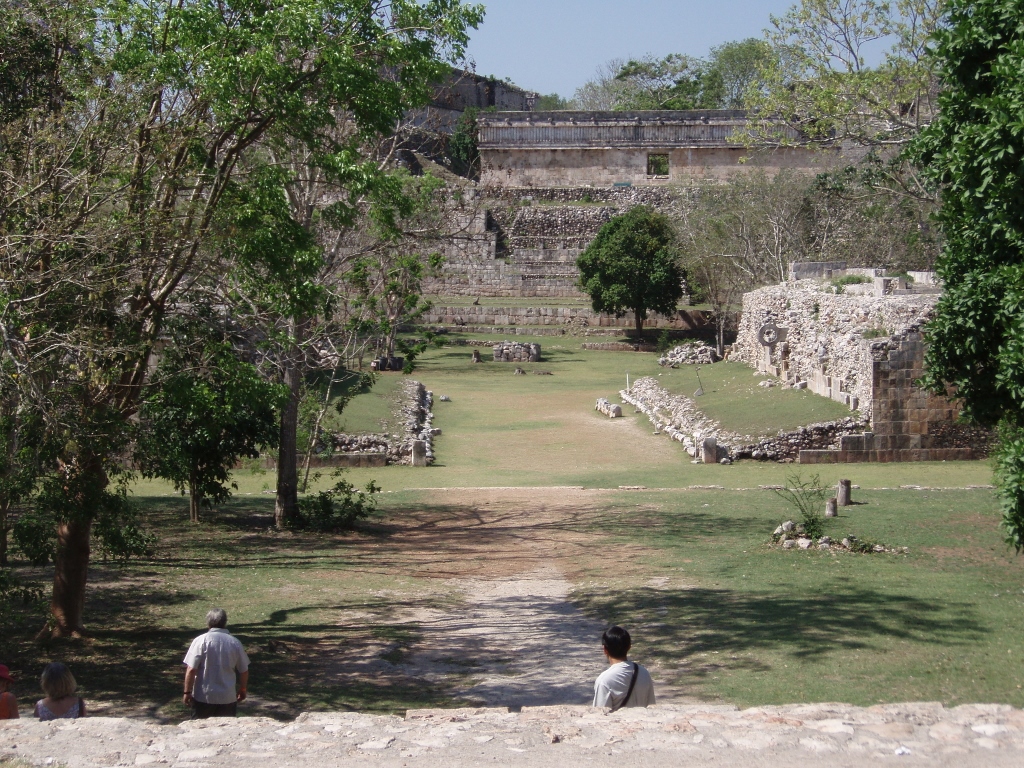 Ballcourt with the House of the Turtles in the background
Ballcourt with the House of the Turtles in the background
An inscription on it says that it was dedicated in 901 CE by ruler Chan Chaak Kʼakʼnal Ajaw and this is the only ruler of Uxmal whose name is known. Also, during the reign of this king, the Nunnery Quadrangle, as well as the Governor’s Palace were built.
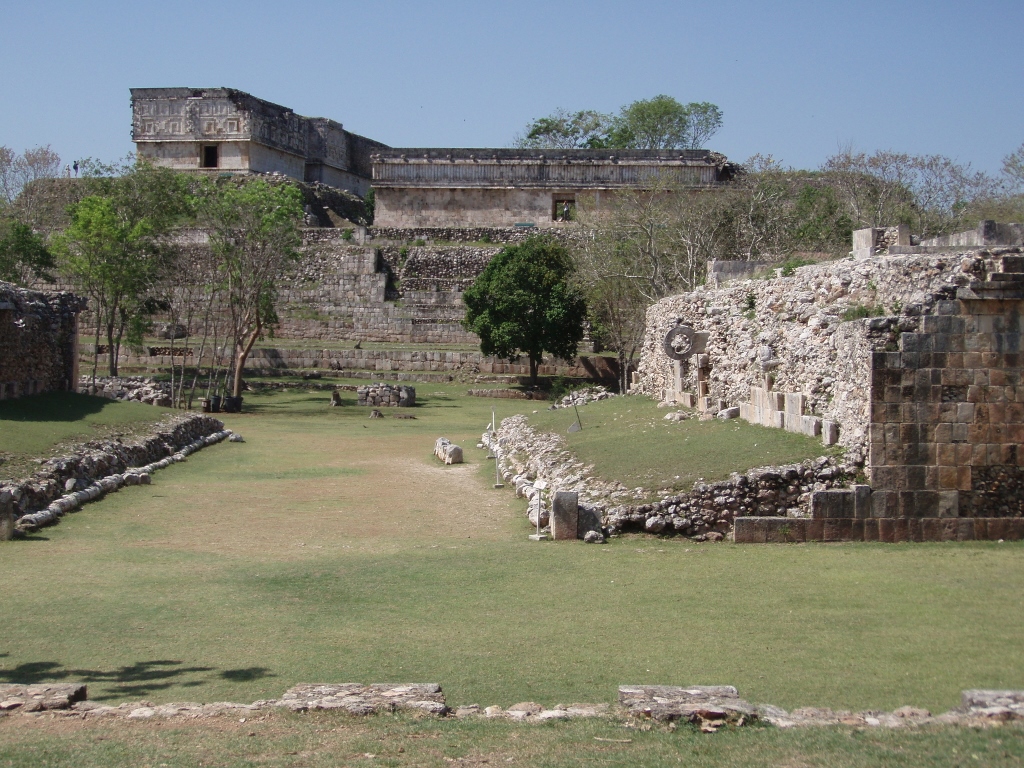 Ballcourt with the Governor’s Palace and the House of the Turtles in the background
Ballcourt with the Governor’s Palace and the House of the Turtles in the background
The Mayan ball games had absolutely nothing to do with sport, but rather they were a religious ceremony the meaning and the rules of are only guessed nowadays. What is known, however, is that the ball was supposed to be thrown through two stone rings that were built into each of the lateral sides of the court. Today, a stone ring may be seen only on one side and according to what I have read, the original has been removed in order to preserve it better, while what is seen on the spot is a reproduction.
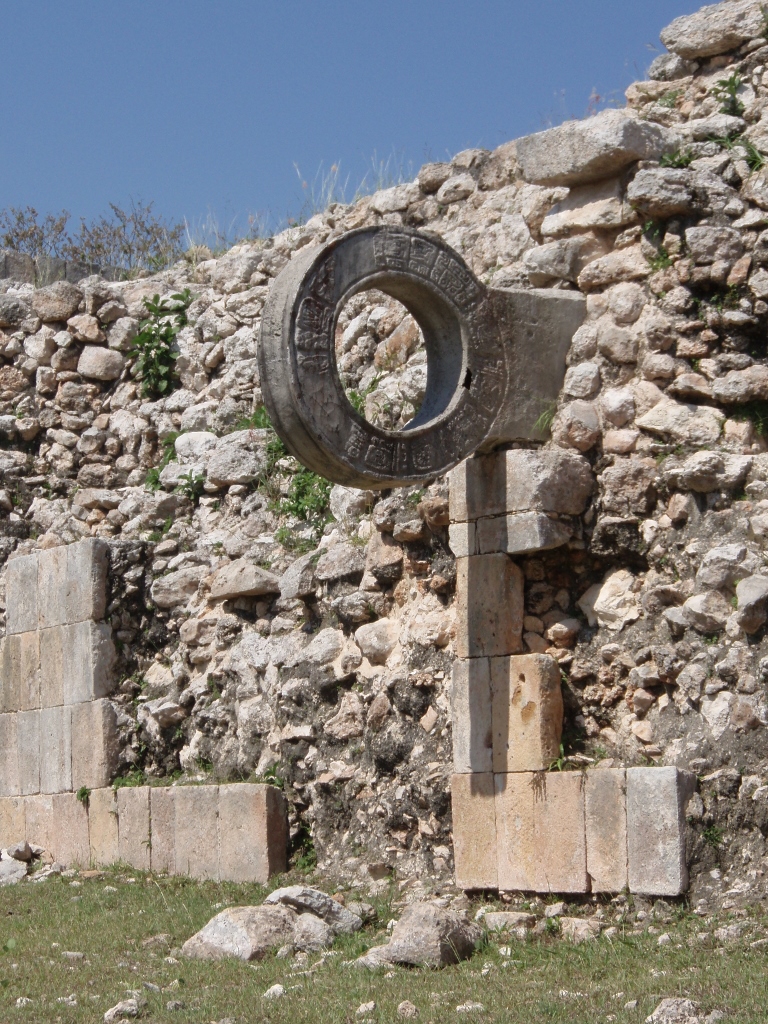 Stone ring at the Ballcourt
Stone ring at the Ballcourt
As it may be seen from the previous photos, in the same direction as the Ballcourt there are some of the more important structures in Uxmal, but I still first followed the visitors’ path which led me to the Cemetery Group. This part is not too significant archaeologically and in terms of the history of art which I concluded on the basis of the fact that very few structures have been preserved there and even fewer have been cleared, but since I had the time I went to see these. The path leads through a sparse forest and in one place it is possible to see a smaller pyramid which covered in vegetation resembled more a simple pile of rocks.
On its south side there is a section with remains of a low wall where it is possible to see nicely a frieze with the depictions of skulls and bones, while nearby there is also something like a platform with a rectangular structure built upon it.
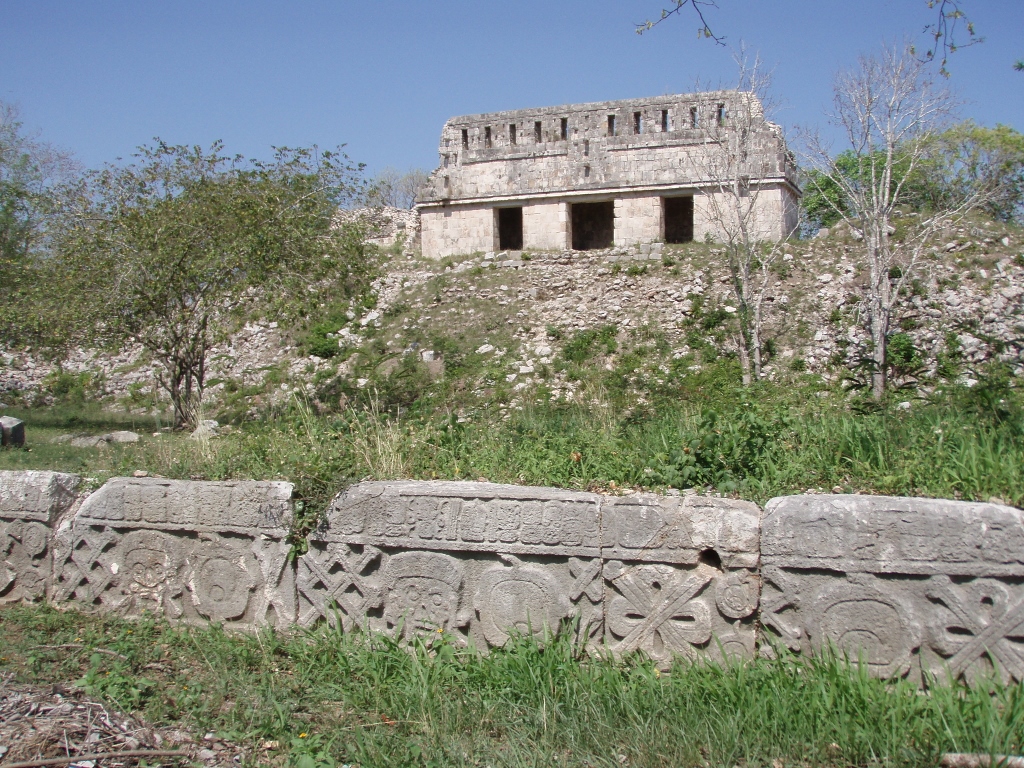 Part of the Cemetery Group
Part of the Cemetery Group
The next structure I went to see was the Dovecote (Casa de las Palomas) which represents remains of a palace that dates back to the period from 670 to 770 CE.
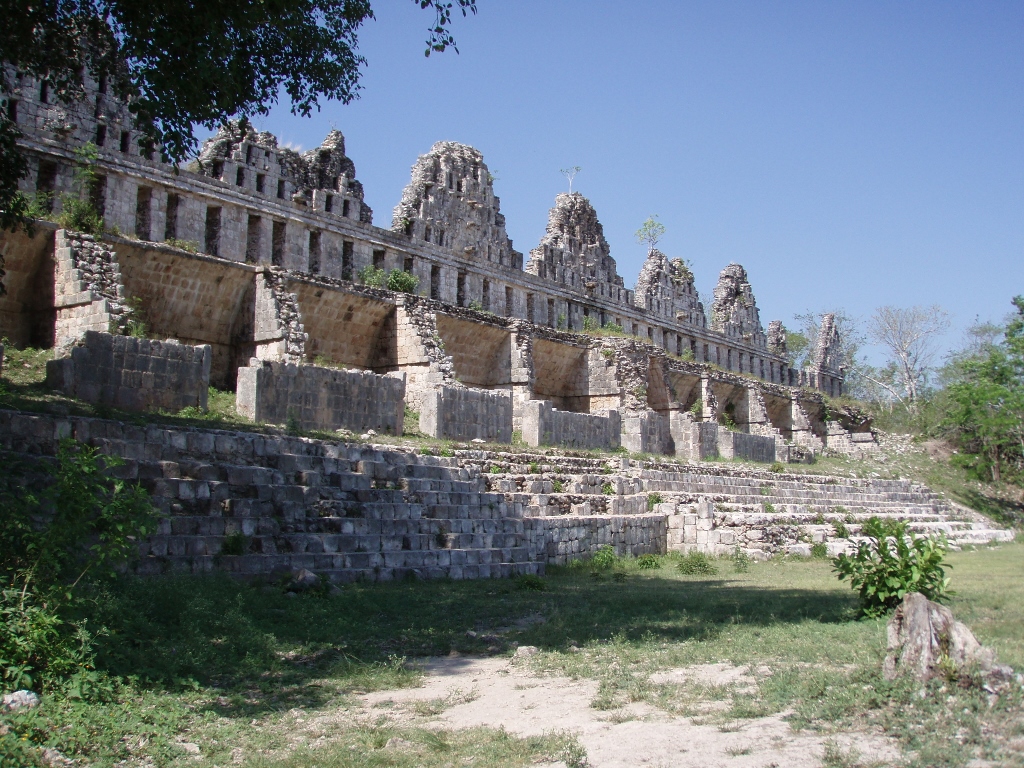 Dovecote
Dovecote
The reason why this structure got its picturesque name is that in the upper sections of the wall, as well as in the nine decorative roof combs there are many holes, openings, and this is reminiscent of entrances into a dovecote. This is all seen even better in the following photo.
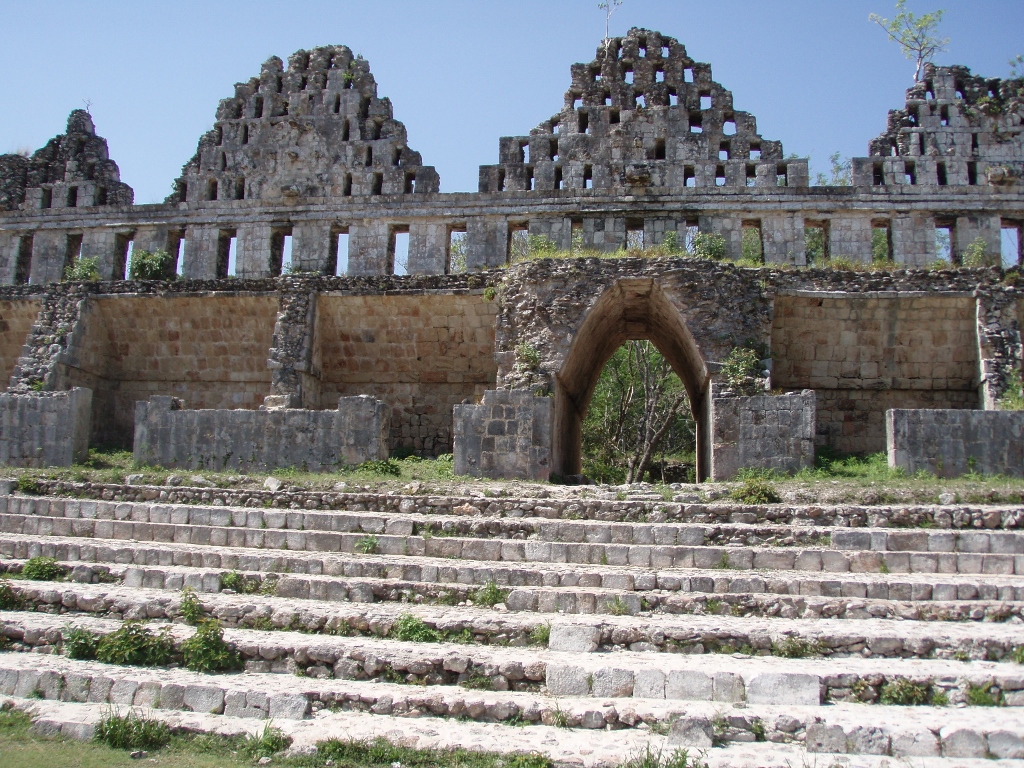 Dovecote
Dovecote
In the photo above it is possible to see very well a passage over which there is a vault that in its base has a corbel arch. It is made by starting at certain height to position the stones on two parallel walls a little more corbelled ones towards the others and then on the “top” place a stone slab over them, thus getting a vault. I have already mentioned before that the ancient Maya did not know how to make proper arches in their construction, but they regularly solved the problem of vaults in this way and this is one of the very typical characteristics of their architecture that can be seen everywhere and for this reason it is interesting to pay attention to the feature.
After a short stay near the Dovecote, I went back to the group of very important structures and the first on my way was the Great Pyramid (La Gran Pirámide).
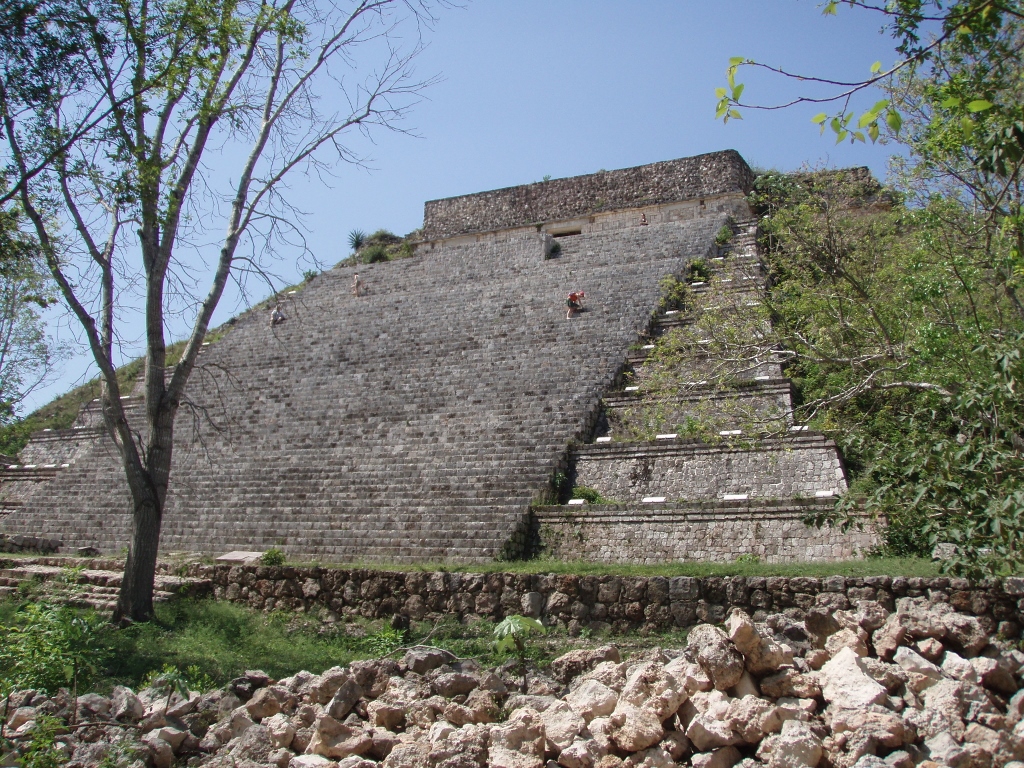 View at the stairway of the Great Pyramid
View at the stairway of the Great Pyramid
The Great Pyramid, built in the 8th century CE, is a stepped pyramid and it has nine large steps or levels. On the north side, which is restored the best and which is 80 metres long at its base, there is a wide stairway leading to a temple on the top of the pyramid that is around 30 metres high.
If one looks at the above photo of the stairway of the Great Pyramid, it is possible to notice that there are some people descending the stairs and they are doing it by moving sideways. What cannot be seen in the photo above, its being static, is that these people descended the stairs very slowly and very carefully.
I will explain this now, but let me first say that the Great Pyramid in Uxmal is one of the small number of large structures of the ancient Mayas that are allowed to be climbed. Still, this needs to be done very carefully. The first reason is that the stairway is very steep and the second one is that the steps are rather high. All of this may not be such a safety issue when ascending, but when descending this is exacerbated by the fact that the steps appear a little narrow, because on account of their height one cannot position the foot well and thus it is safer to descend them sideways, for then one is sure to place the entire foot on the step in a stable manner. In addition, I remember from the past, when I used to go hiking a lot and when we ascended (and descended) over steep rocky sections, that I was advised that the safest way to descend is in fact to go “backward,” i.e., facing the slope down which I was going and looking down between my legs where I was to put my foot. When one descends steep sections walking straight, it is very easy for a foot to slip because one cannot see well where one is stepping or, if one is to lean forward to see better, the upper part of the body may pull one forward and then the person may topple, which leads to a chaos. Bearing all of this in mind, the best solution for descending down the Great Pyramid in Uxmal is to walk sideways.
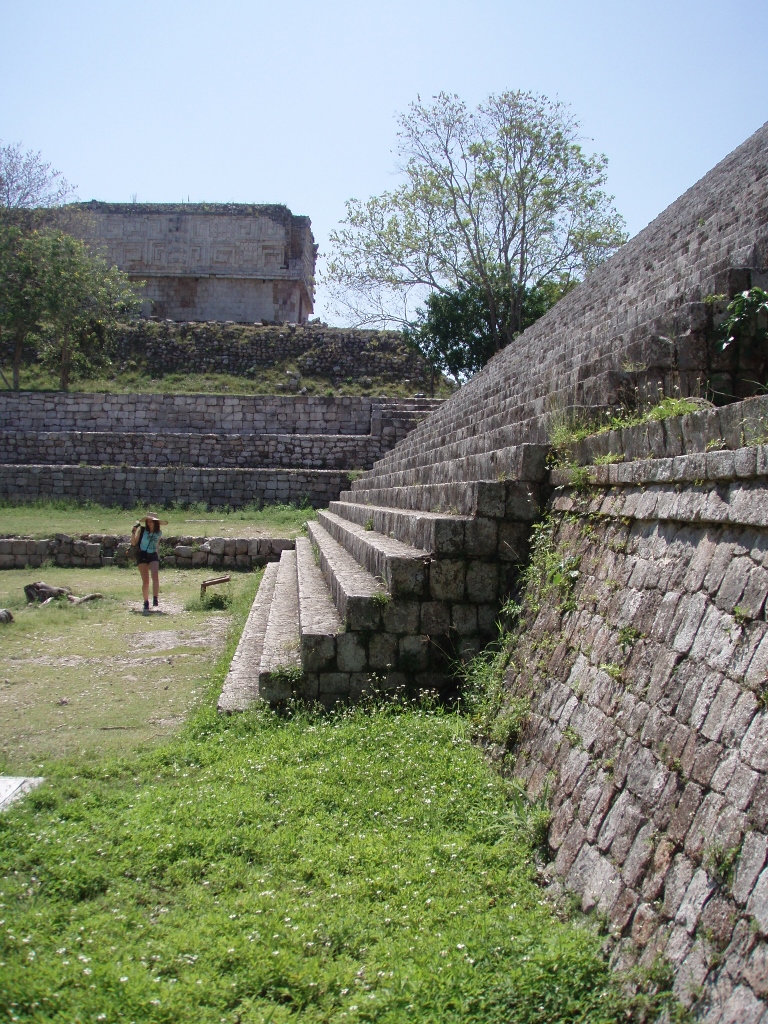 Stairway of the Great Pyramid
Stairway of the Great Pyramid
After taking some photos, I started valiantly to go up. When I say that the pyramid is around 30 metres high, this may not sound like a lot, but when one realises that this is approximately the height of the 10th floor in the standard high-rise buildings, then it is not negligible. What I want to say is that this is not unattainable, but I certainly appreciated it when I got to a narrow platform approximately at the level of the fifth step of the pyramid, for I took advantage of this in order to sit down, catch my breath and take a couple of photos.
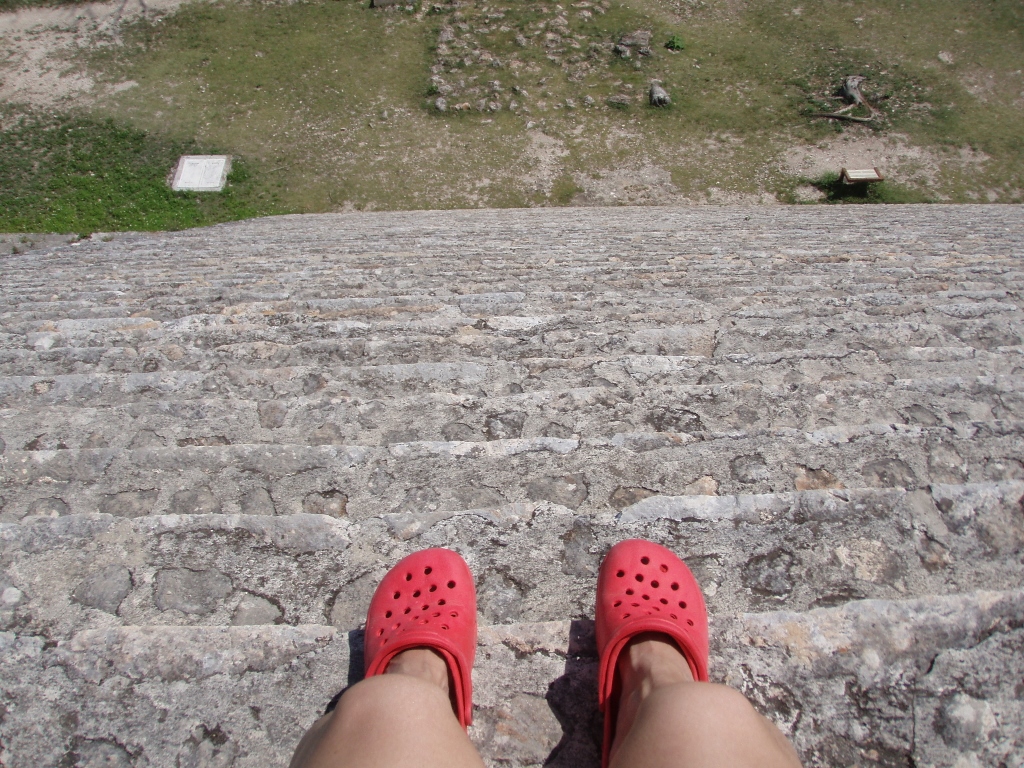 View down the stairway from the platform at the level of the fifth step of the Great Pyramid
View down the stairway from the platform at the level of the fifth step of the Great Pyramid
While I was sitting there and resting, I felt a little embarrassed for becoming breathless, especially when I saw an iguana climbing up towards the top of the pyramid without any breaks.
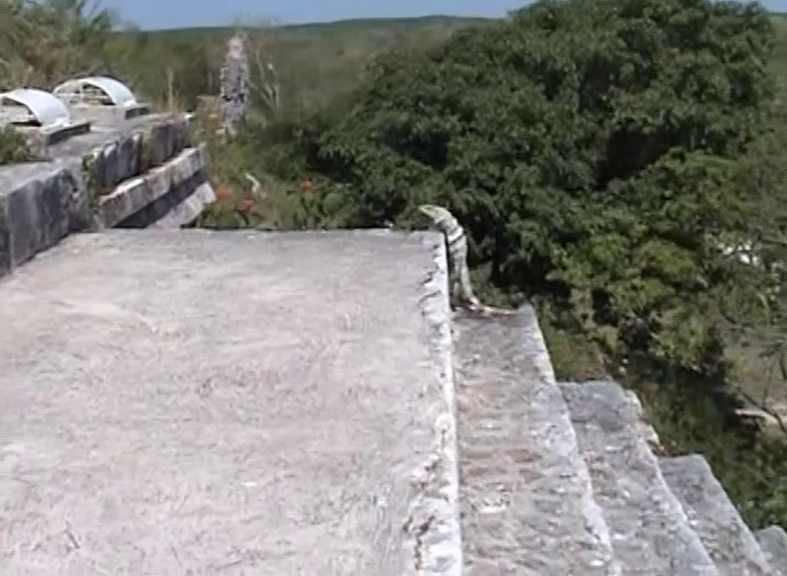 Iguana climbing up towards the top of the Great Pyramid without any complaints (in the background there is a side view at the roof combs of the Dovecote)
Iguana climbing up towards the top of the Great Pyramid without any complaints (in the background there is a side view at the roof combs of the Dovecote)
After the break I continued going up to the very top and there I was breathless again, not necessarily on account of the climbing (there are fewer steps there), but because of the fantastic view at the site and Yucatan.
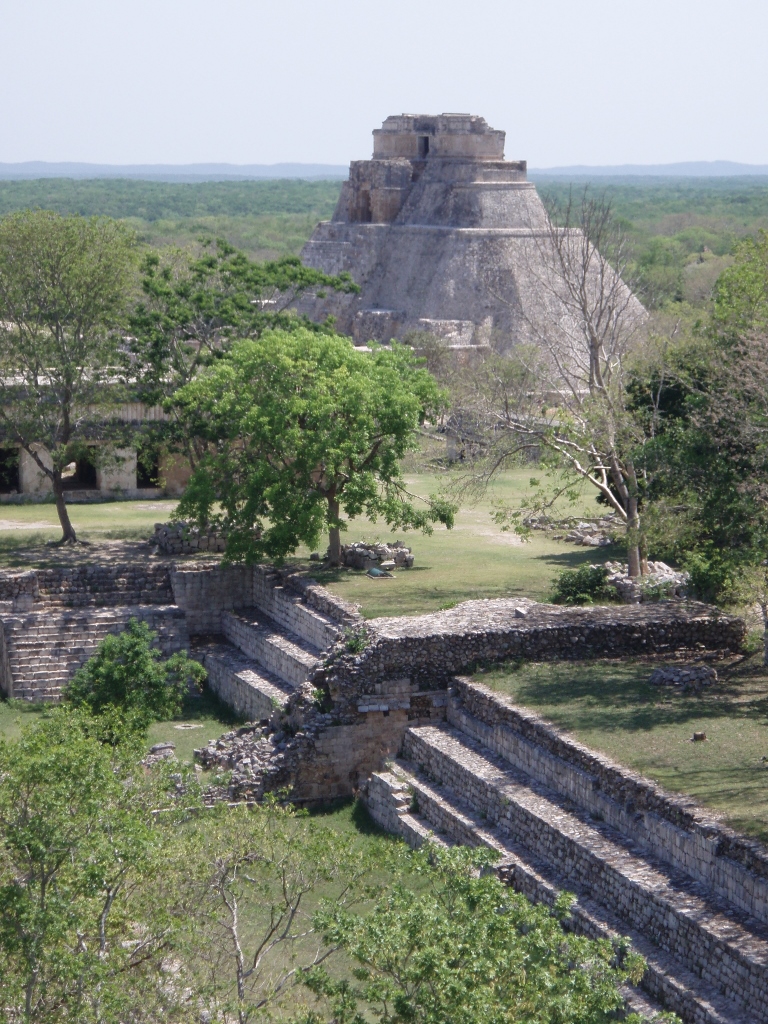 View at the Pyramid of the Soothsayer in Uxmal
View at the Pyramid of the Soothsayer in Uxmal
There I also made a self-portrait.
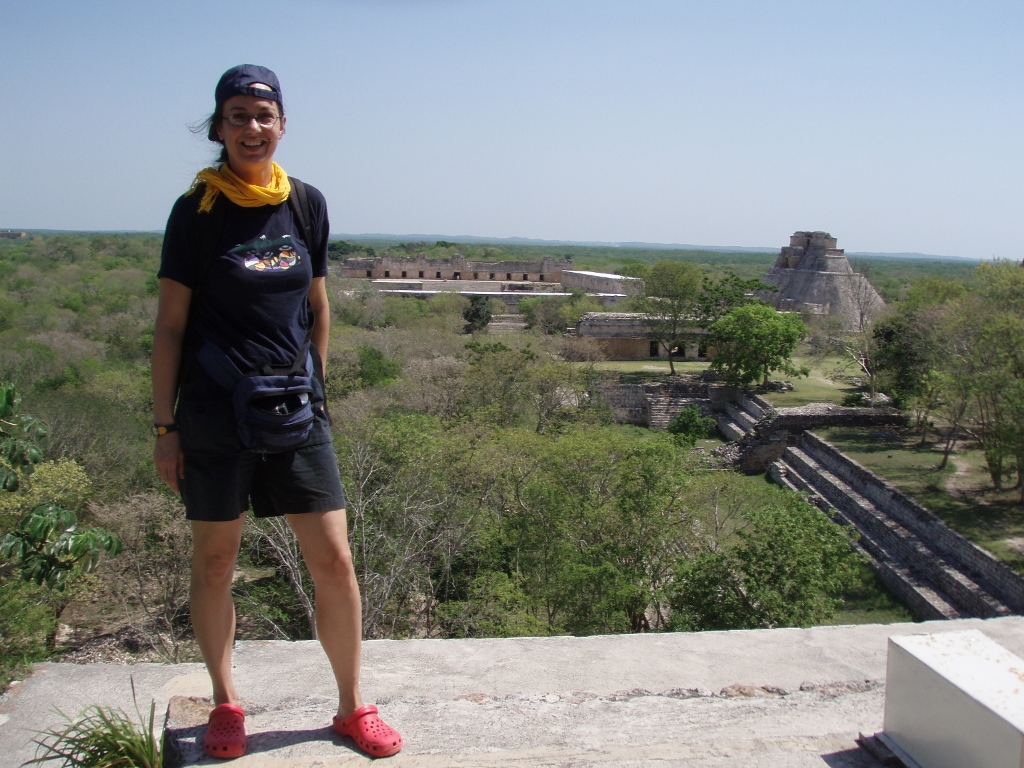 View at Uxmal site
View at Uxmal site
On the top of the pyramid there is a temple which in its centre has a smaller, shallow room the entering of which is not permitted, while on the back wall of the room there is a large depiction of god Chaac, admittedly seemingly a little dug-in, for his nose was at the level of the floor.
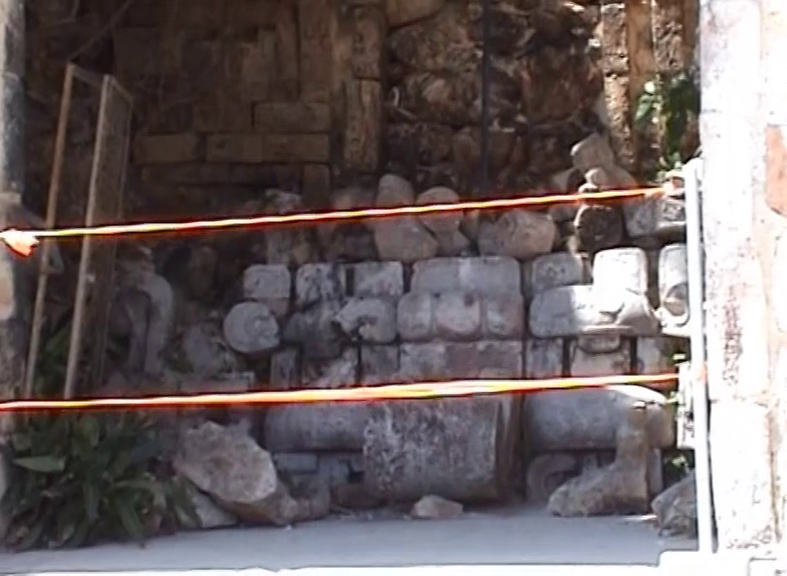 God Chaac in the shrine on the top of the Great Pyramid in Uxmal
God Chaac in the shrine on the top of the Great Pyramid in Uxmal
The depictions of god Chaac also adorn the corners of the temple, only here some details, such as the ear ornaments are round and not square as is usual.
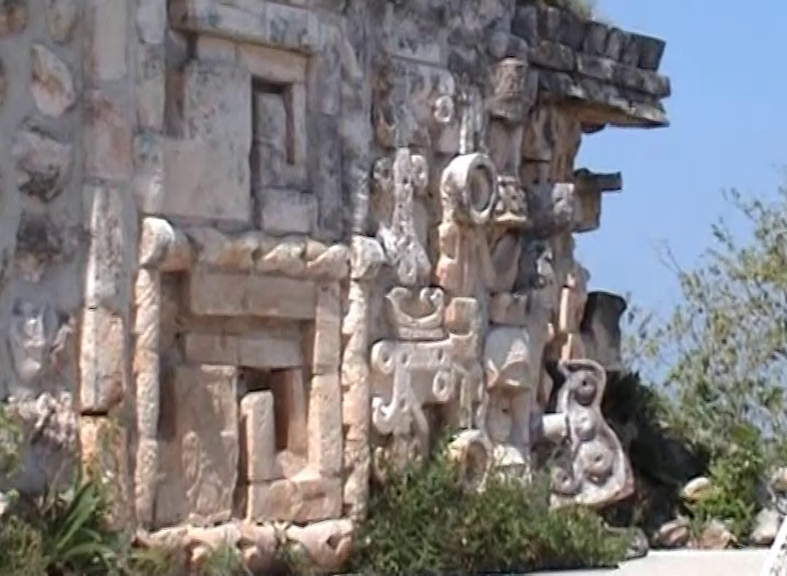 Corner of the temple on the top of the Great Pyramid in Uxmal
Corner of the temple on the top of the Great Pyramid in Uxmal
But, in addition to the standard depiction of god Chaac, this temple also has other ornaments, the most interesting being those that show macaws.
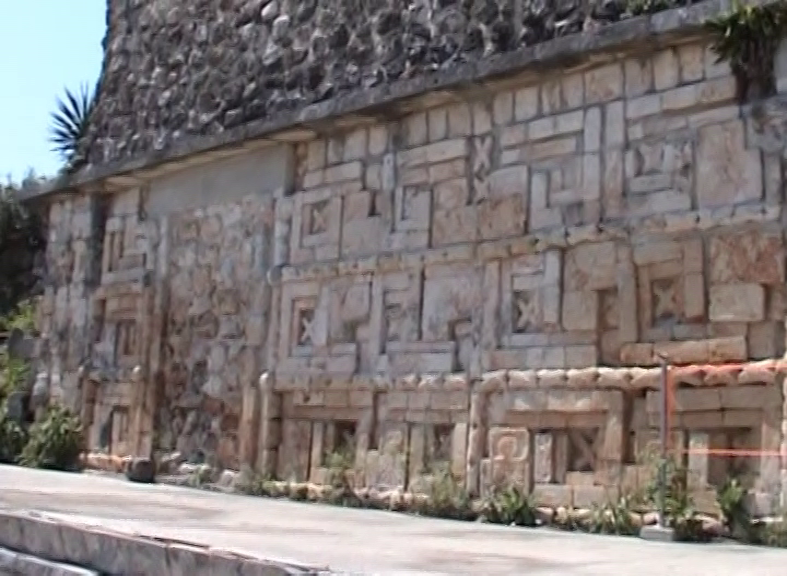 Panel on the left-hand wing of the temple on the top of the Great Pyramid
Panel on the left-hand wing of the temple on the top of the Great Pyramid
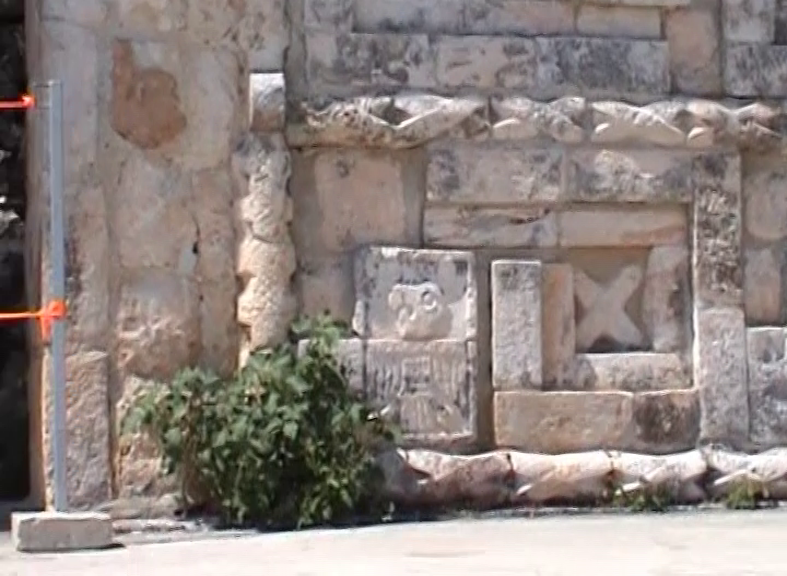 Detail from the right-hand wing of the temple where the depiction of a macaw can be seen well
Detail from the right-hand wing of the temple where the depiction of a macaw can be seen well
These bas-reliefs of macaws also render the structure its other name – the Temple of the Macaws (Templo de las Guacamayas). Since in the Mayan world macaws used to be linked to fire, this would suggest that the temple was dedicated to the Sun.
I enjoyed the stunning view from the top of the Great Pyramid for a while yet and then I started to descend slowly. Needless to say, I did it very carefully and unhurriedly, and my main problem was that I have big feet. Admittedly, on the other hand it was good that I have long legs, so the height of the stairs was not much of a challenge at least not for me personally.
When I got down I headed for the Governor's Palace and so I passed by the lateral, east side of the Great Pyramid. It was interesting to see that it was in the shape of a pile of stones. What I want to say with this is that it’s an open question what is yet to be discovered under bigger or smaller piles of stones that exist on the site.
By the way, it is believed that all of these pyramids used to be painted in red with addition of some other colours, such as yellow, blue and green. It must have looked magnificent then!
The next structure along the rest of my sightseeing route around the ancient Mayas’ city of Uxmal was the Governor’s Palace (Palacio del Gobernador). It was built on a high platform in the period from the 9th to the 10th century CE and its ground plan has the shape of an elongated rectangle. It practically consists of three structures connected by Mayan arches and the upper zone which is very richly decorated and which constitutes the longest facade in the Pre-Columbian Mesoamerica. It is precisely with all of its decorations that the palace represents the peak of the Puuc architectural and artistic style. This is seen particularly well in the morning, when the front facade situated on the east side is lit by the Sun.
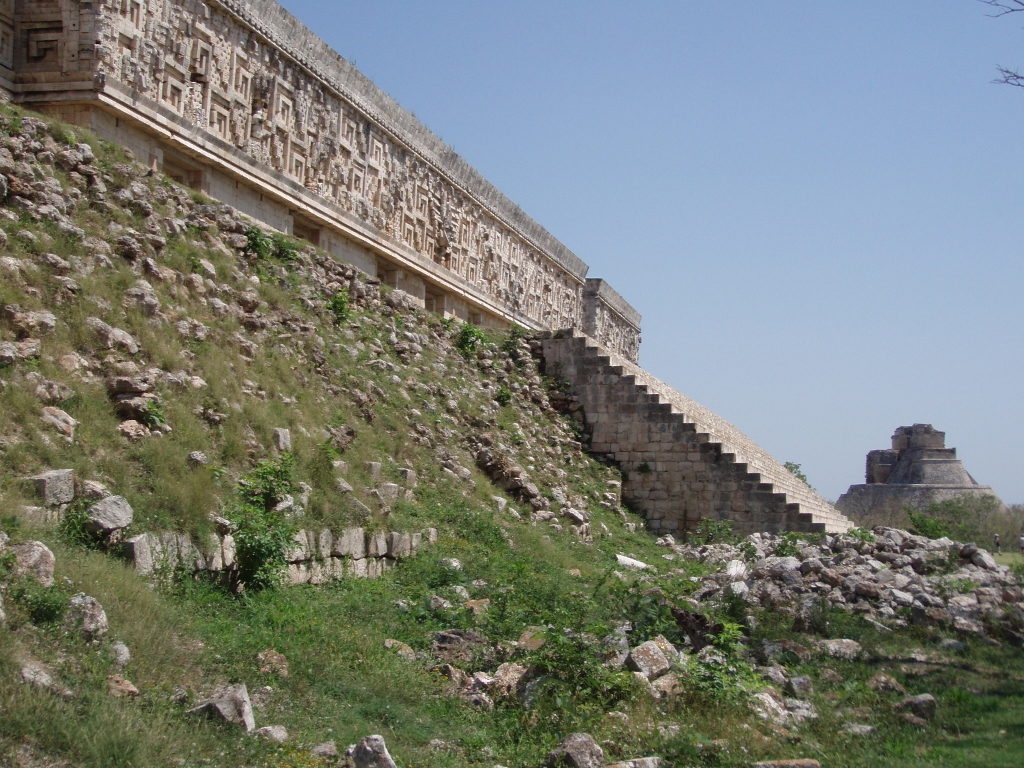 Governor’s Palace
Governor’s Palace
The palace is almost 100 metres long, it is 12 m wide and 9 m high. As it is situated on a large platform, it may be reached by a wide stairway on the east side.
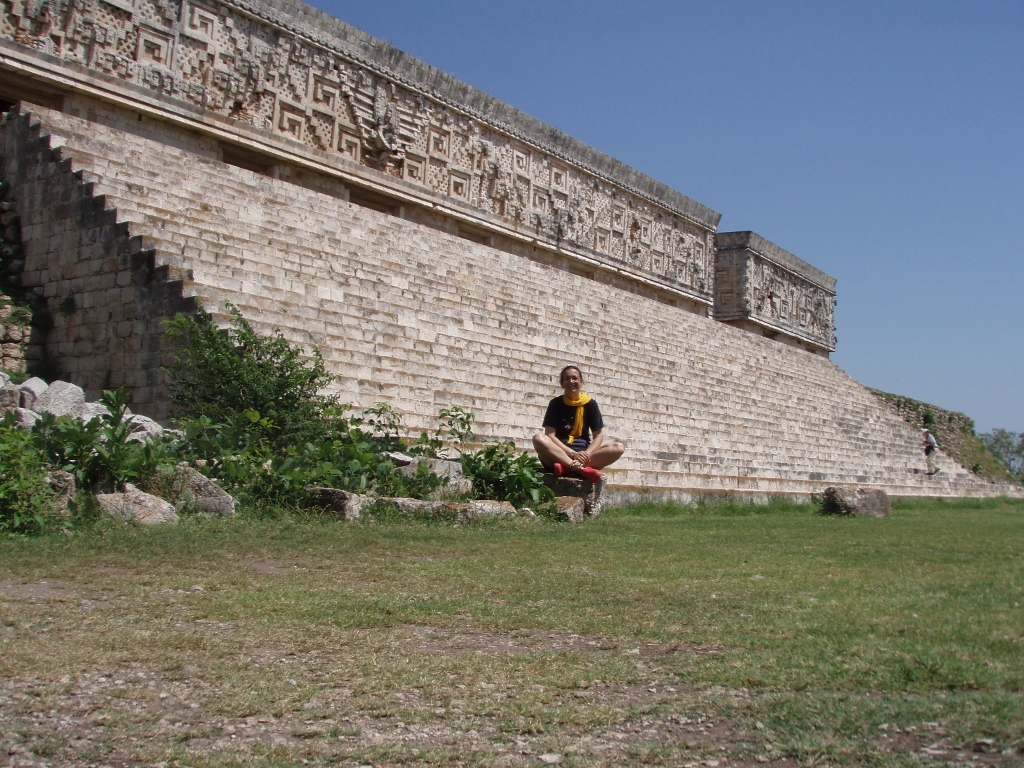 Governor’s Palace – the stairway and the opulent decoration on the upper section of the front facade
Governor’s Palace – the stairway and the opulent decoration on the upper section of the front facade
Still, regardless of the possibility to get to the base of the structure and the rooms, its most important segment is precisely this fantastic and richly decorated front facade and it really deserves a more thorough look.
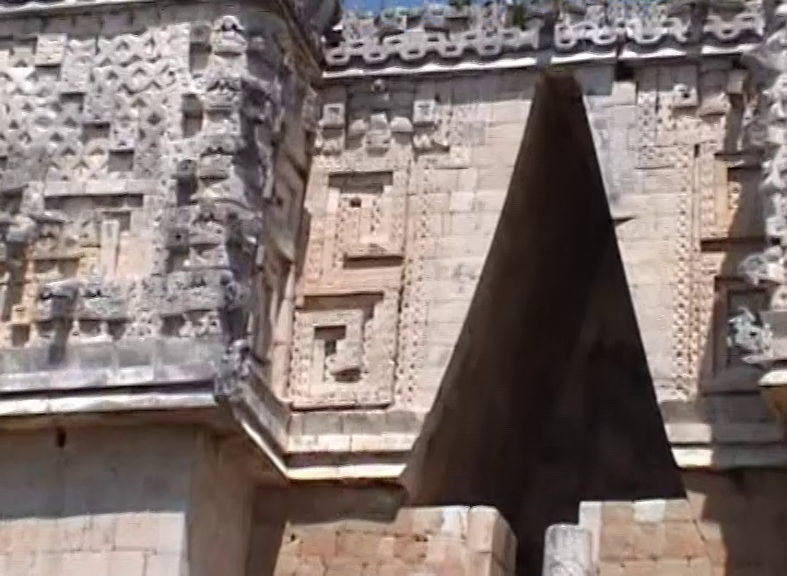 The Governor’s Palace – a detail with a Mayan arch and details of the rich stone decoration
The Governor’s Palace – a detail with a Mayan arch and details of the rich stone decoration
As it may be seen in the photo above, on each corner there are depictions of the god of rain and consequently of fertility, Chaac. But, the masks of god Chaac are also positioned in a sequence, like a ribbon along the entire length of the front facade where they adorn it by going up and down like a wave. This will be seen better in a couple of photographs further below, but for now here are a couple of details in order to see how impressively and richly the facade is decorated with stone plastics. The following photo also shows two masks of god Chaac placed above the angular spirals.
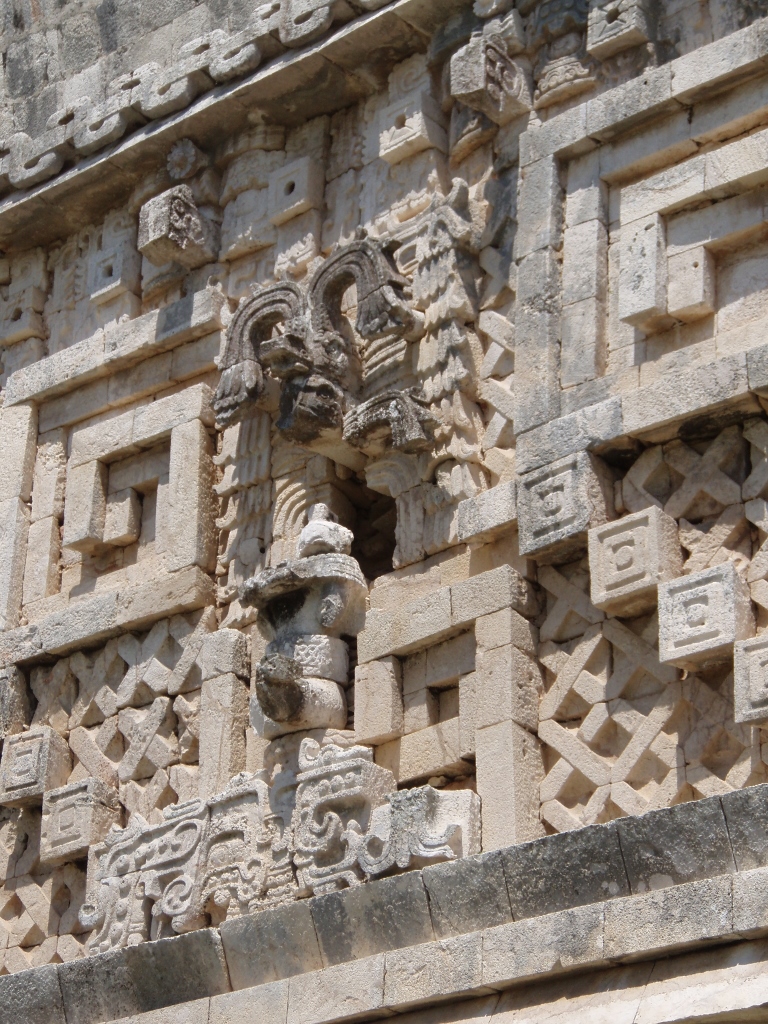 The Governor’s Palace – a detail of the stone decoration on the front facade
The Governor’s Palace – a detail of the stone decoration on the front facade
Needless to say, in this multitude of ornaments, the experts have found some very important elements, such as almost 400 Venus glyphs placed on the cheeks of god Chaac, because it was precisely some specific position of Venus that marked the beginning of the rain season that was so important for the ancient Mayas and for their crop growing. It is also important that this position repeats every eight years and therefore number 8 is shown here either in the shape of the Mayan sign for this number that can be seen in a couple of places or in the shape of eight two-headed serpents that adorn the front facade above the main entrance into the palace.
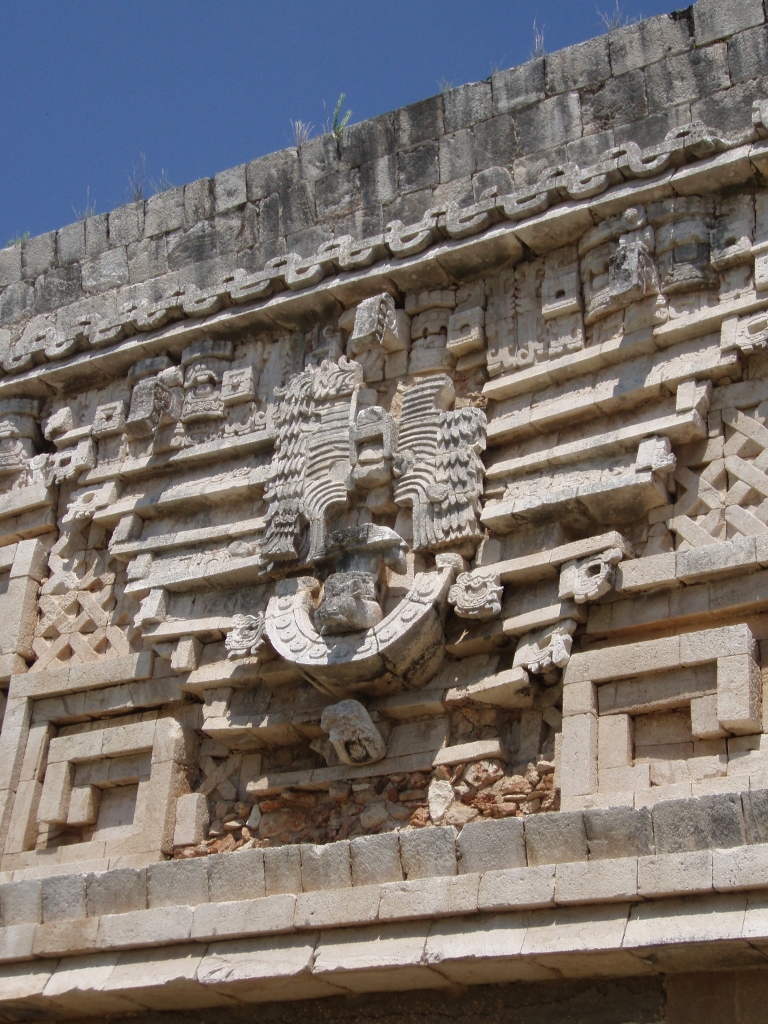 The Governor’s Palace – eight two-headed serpents above the main entrance
The Governor’s Palace – eight two-headed serpents above the main entrance
In front of the palace there is a very nice and spacious courtyard and the main structure in it is the Platform of the Jaguars which is presumed to have served as a ceremonial altar. Still, what is most important here and on the basis of which the platform got its name is the Jaguar Throne. This is a stone throne carved in the shape of a two-headed jaguar, while the jaguar was always the symbol of chiefs and kings here.
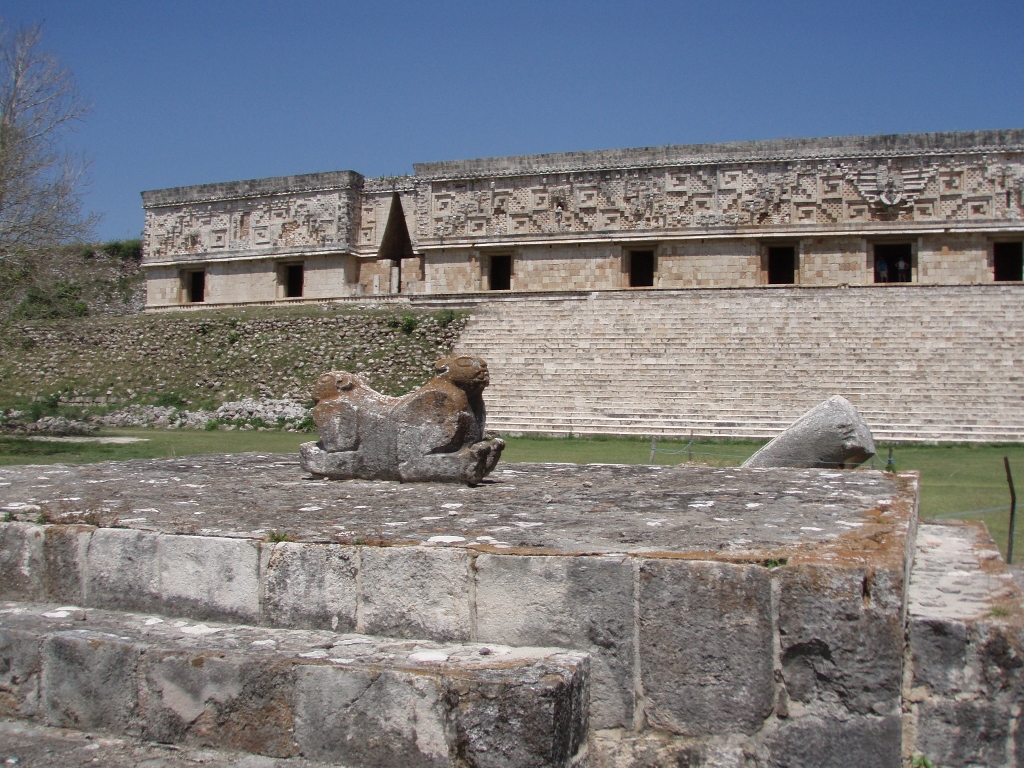 Platform of the Jaguars and the Governor’s Palace
Platform of the Jaguars and the Governor’s Palace
From here, there was also a fine view at the stairway and the Governor’s Palace, as well as the wavy sequence of the masks of god Chaac I have mentioned above. If you pay close attention, it is possible to see that the masks on the photo below start to go in a sequence from the left and bottom, while in the middle they are already up, before going down again towards the right-hand side of the photo.
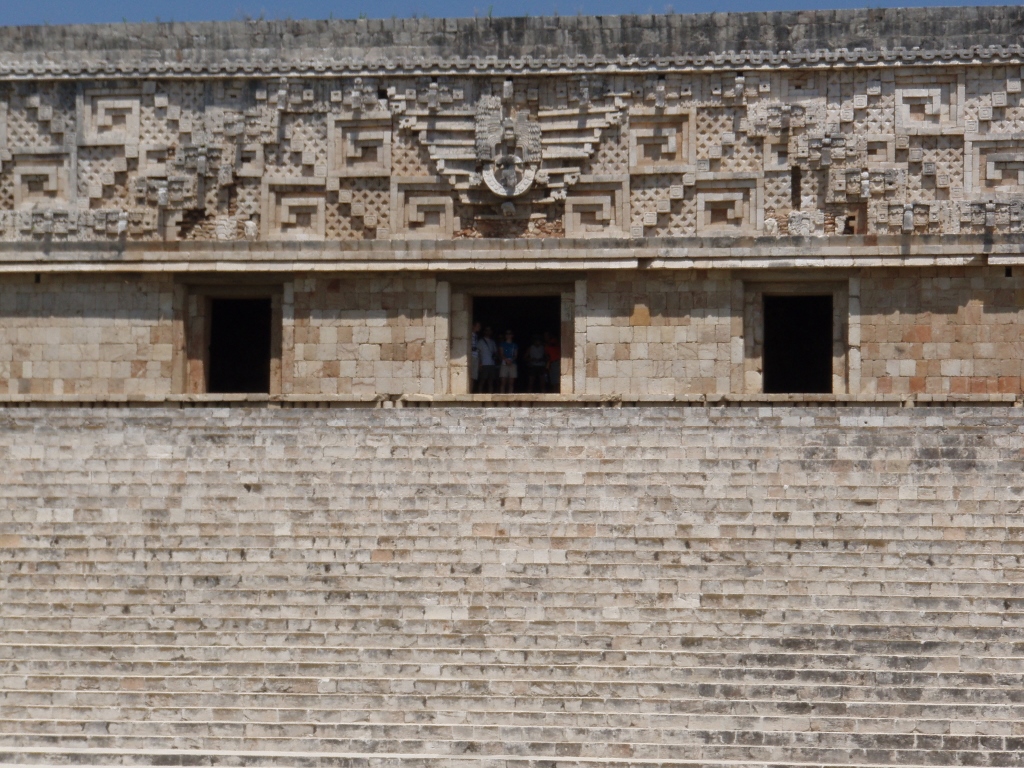 The Governor’s Palace – the stairway and the central section of the front facade
The Governor’s Palace – the stairway and the central section of the front facade
Then I went up to the palace itself, but apart from being able to peek into a couple of rooms, there was nothing else I could see inside.
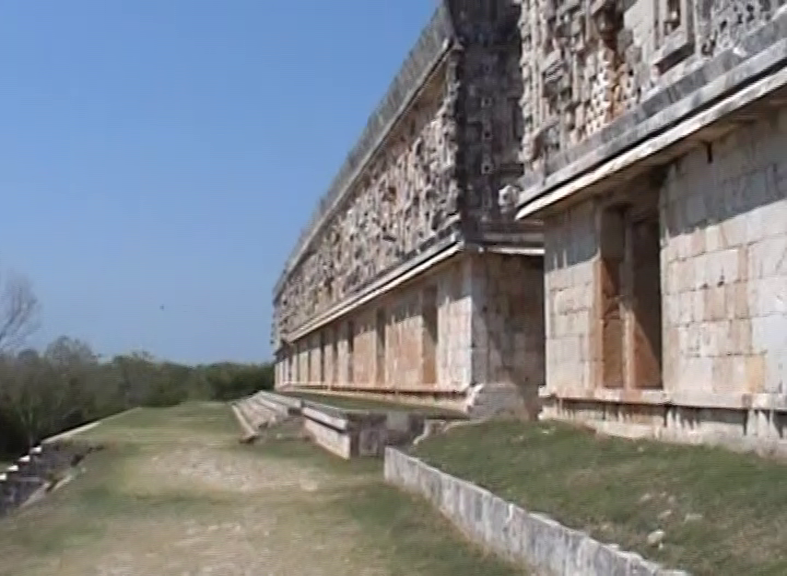 The Governor’s Palace – the platform in front of the palace
The Governor’s Palace – the platform in front of the palace
Still, from the platform there was a nice view at the Pyramid of the Soothsayer.
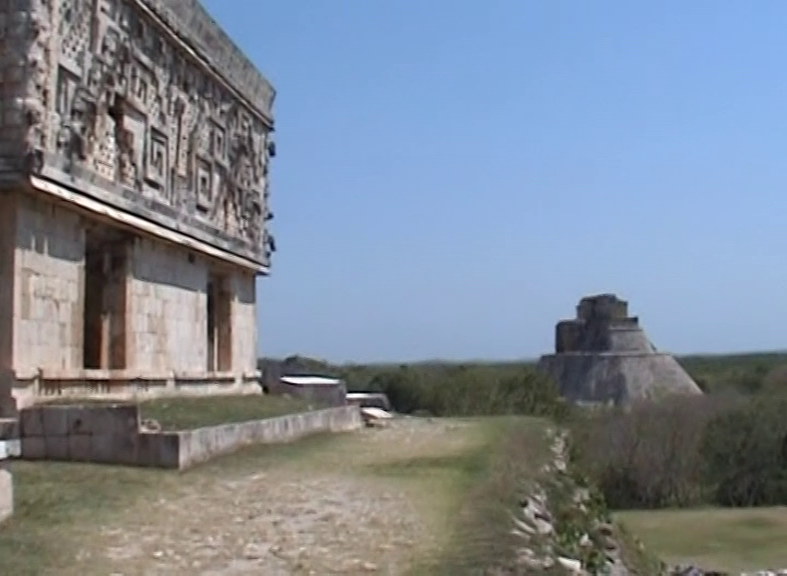 Part of the Governor’s Palace and the Pyramid of the Soothsayer
Part of the Governor’s Palace and the Pyramid of the Soothsayer
While I was walking along this platform, I was delighted when I noticed a detail that is probably not very important, but I found it very interesting. This was a mask of god Chaac that decorates a corner of the structure dug into the ground, which seems like a rain drainage canal.
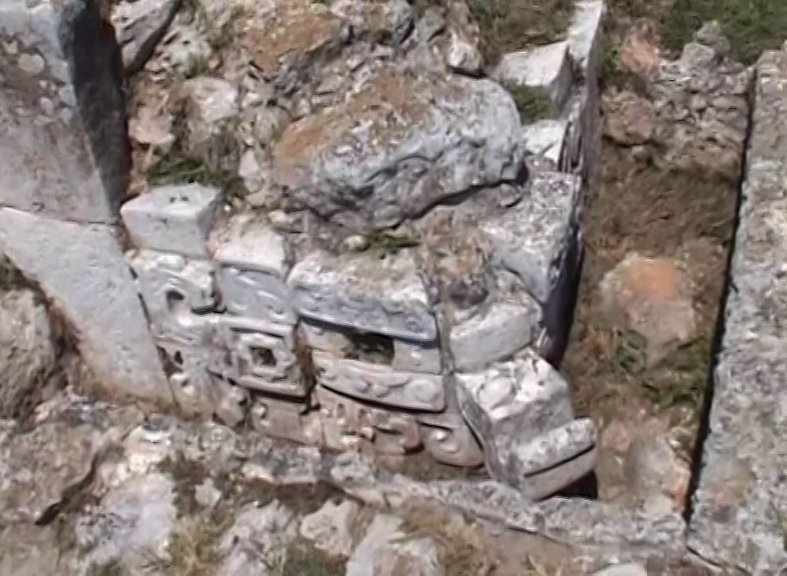 Mask of god Chaac and a rain drain dug into the ground
Mask of god Chaac and a rain drain dug into the ground
Here I also finished with my sightseeing of the Governor’s Palace, while the view of the archaeological site of Uxmal I had from there pulled me as if I were mesmerised and inspired me to move forward without even looking back at the palace. This is in fact a pity since probably the most beautiful view at the palace is from the northeast side, but I don’t have such a photograph. On the other hand, I have the following one and it serves me as a justification for my “carelessness.”
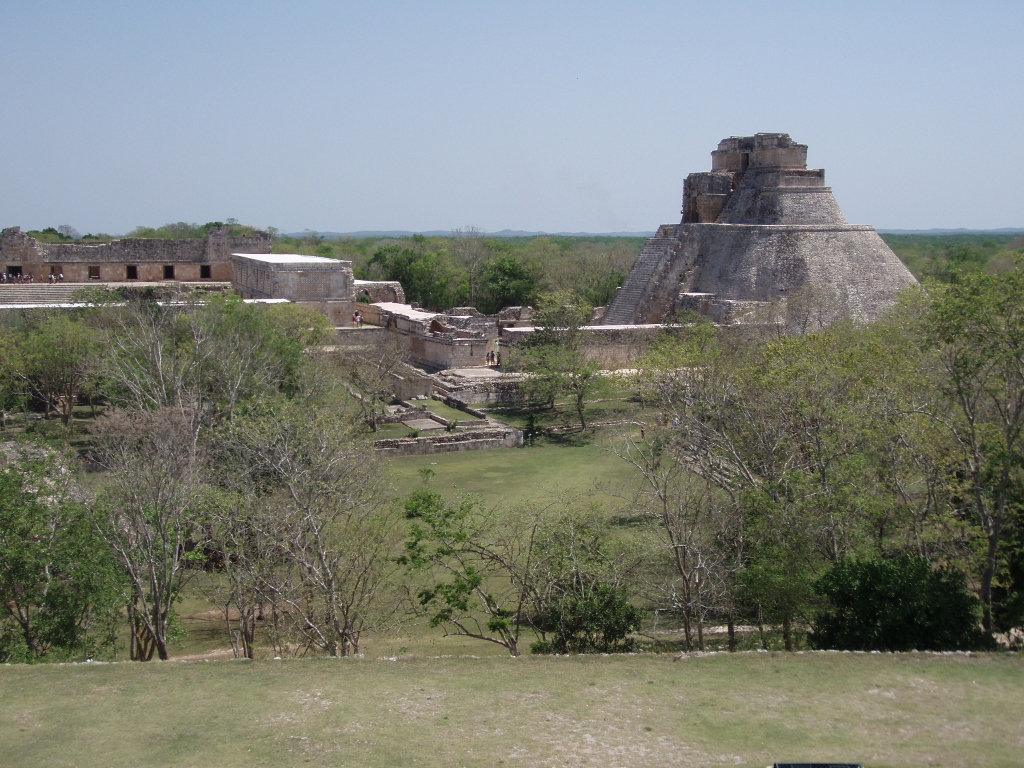 Uxmal
Uxmal